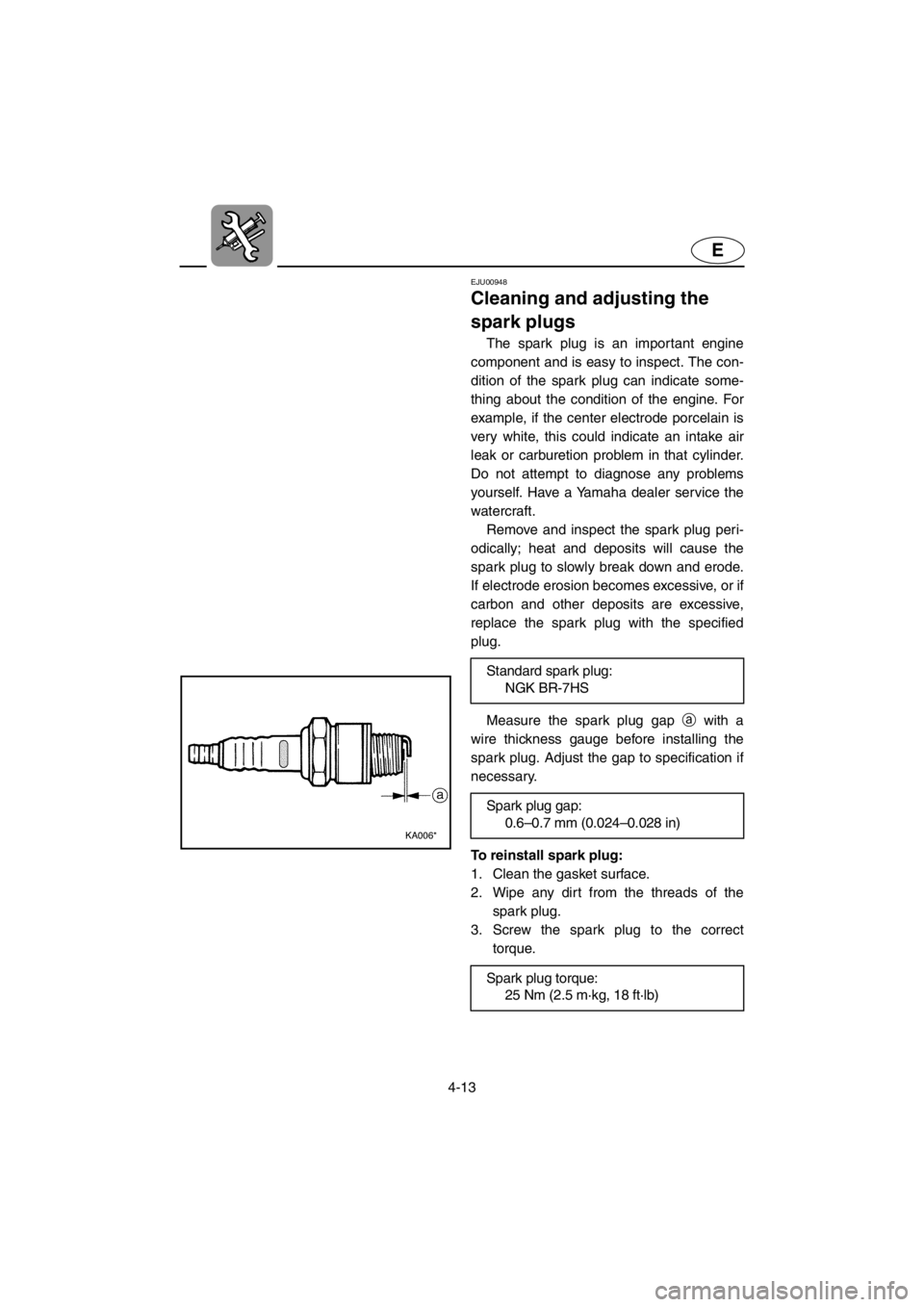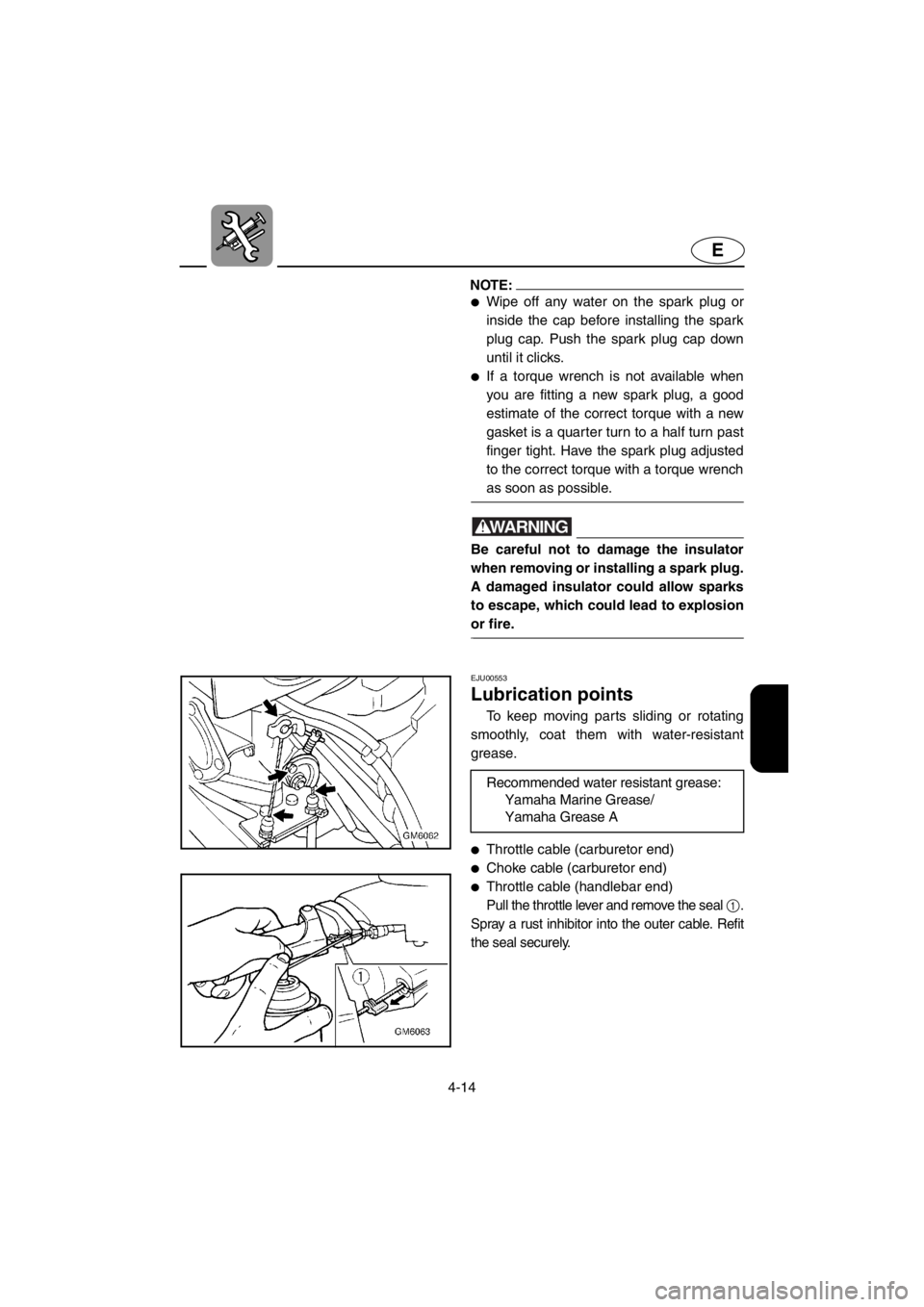Page 77 of 107
4-8
E
Owner’s/Operator’s Manual
and tool kit
It is advisable always to carry the
Owner’s/Operator’s Manual and tool kit with
you whenever you use the watercraft. For
your convenience, a storage pouch 1 is
provided on the watercraft for the manual
and tool kit.
NOTE:
To protect these materials from water dam-
age, it would be a good idea to put them in a
waterproof bag. If your Owner’s/Operator’s
Manual is damaged, order a replacement
from a Yamaha dealer.
@
The service information included in this
manual is intended to provide you, the
owner, with the necessary information for
completing your own preventive mainte-
nance and minor repairs. The tools provided
in the tool kit 2 are sufficient for this pur-
pose, except that a torque wrench may also
be necessary to tighten nuts and bolts.
E_GM6-4.fm Page 8 Tuesday, July 11, 2000 11:28 AM
Page 82 of 107

4-13
E
EJU00948
Cleaning and adjusting the
spark plugs
The spark plug is an important engine
component and is easy to inspect. The con-
dition of the spark plug can indicate some-
thing about the condition of the engine. For
example, if the center electrode porcelain is
very white, this could indicate an intake air
leak or carburetion problem in that cylinder.
Do not attempt to diagnose any problems
yourself. Have a Yamaha dealer service the
watercraft.
Remove and inspect the spark plug peri-
odically; heat and deposits will cause the
spark plug to slowly break down and erode.
If electrode erosion becomes excessive, or if
carbon and other deposits are excessive,
replace the spark plug with the specified
plug.
Measure the spark plug gap a with a
wire thickness gauge before installing the
spark plug. Adjust the gap to specification if
necessary.
To reinstall spark plug:
1. Clean the gasket surface.
2. Wipe any dirt from the threads of the
spark plug.
3. Screw the spark plug to the correct
torque. Standard spark plug:
NGK BR-7HS
Spark plug gap:
0.6–0.7 mm (0.024–0.028 in)
Spark plug torque:
25 Nm (2.5 m·kg, 18 ft·lb)
E_GM6-4.fm Page 13 Tuesday, July 11, 2000 11:28 AM
Page 83 of 107

4-14
E
NOTE:@●Wipe off any water on the spark plug or
inside the cap before installing the spark
plug cap. Push the spark plug cap down
until it clicks.
●If a torque wrench is not available when
you are fitting a new spark plug, a good
estimate of the correct torque with a new
gasket is a quarter turn to a half turn past
finger tight. Have the spark plug adjusted
to the correct torque with a torque wrench
as soon as possible.
@
WARNING@Be careful not to damage the insulator
when removing or installing a spark plug.
A damaged insulator could allow sparks
to escape, which could lead to explosion
or fire.
@
EJU00553
Lubrication points
To keep moving parts sliding or rotating
smoothly, coat them with water-resistant
grease.
●Throttle cable (carburetor end)
●Choke cable (carburetor end)
●Throttle cable (handlebar end)
Pull the throttle lever and remove the seal 1.
Spray a rust inhibitor into the outer cable. Refit
the seal securely.
Recommended water resistant grease:
Yamaha Marine Grease/
Yamaha Grease A
E_GM6-4.fm Page 14 Tuesday, July 11, 2000 11:28 AM
Page 89 of 107

4-20
E
EJU00578
Replacing the fuse
The fuse is in the electrical box 1.
To replace the fuse:
1. Remove the cap 2, pull out the red lead,
and bring the fuse holder 3 out of the
electrical box.
2. Open the fuse holder and replace the
fuse4 with one of the correct amper-
age.
WARNING@Do not use fuses of higher amperage
than those recommended. Substitution
of a fuse of improper rating can cause
extensive electrical system damage and
possible fire.
@
Fuse amperage: 10 A
EJU00582
Adjusting the steering friction
The amount of friction in the steering can
be adjusted to suit operator preference.
To adjust the friction:
1. Loosen the four screws, and then
remove the handlebar cover.
2. Turn the handlebars as far as possible to
starboard (right).
3. Loosen the locknut 2.
4. Tighten or loosen the adjusting nut 1
until the desired amount of friction is
reached.
5. Hold the adjusting nut with one wrench
while tightening the locknut with another
wrench.
Tightening torque:
29 Nm (2.9 m·kg, 21 ft·lb)
E_GM6-4.fm Page 20 Tuesday, July 11, 2000 11:28 AM
Page 91 of 107
4-22
E
To change the position for the steering
cable pivot bolt:
1. Pull back the outer sleeve, and then dis-
connect the steering cable.
2. Remove the steering cable joint from the
steering cable pivot bolt.
3. Loosen the pivot bolt and install it with
the lock washer in the desired position
(P1 or P2). Make sure to tighten it to the
specified torque.
4. Install the steering cable joint on the
steering cable pivot bolt.
To change the handlebar stopper posi-
tion:
1. Loosen the handle stopper nut 2 on the
operator’s side of the steering pole.
2. Lift and turn the handlebar stopper to the
desired position (S1 or S2), and then
tighten the handlebar stopper nut. Make
sure to tighten it to the specified torque.
3. Install the steering pole cover securely. Tightening torque:
5.4 Nm (0.5 m·kg, 3.9 ft·lb)
Tightening torque:
31 Nm (3.1 m·kg, 22.4 ft·lb)
E_GM6-4.fm Page 22 Tuesday, July 11, 2000 11:28 AM